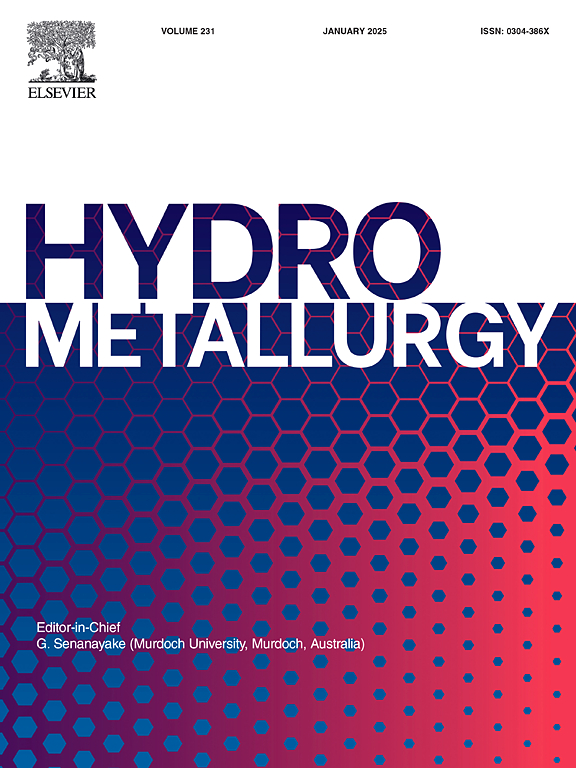A preliminary study of electro-reduction pretreatment preceding chalcopyrite leaching in ammonium chloride media in the presence of copper ions
IF 4.8
2区 材料科学
Q1 METALLURGY & METALLURGICAL ENGINEERING
引用次数: 0
Abstract
Chalcopyrite has notoriously slow dissolution kinetics in oxidative leaching media. Pre-conditioning using electro-reduction is a potential alternative, aimed at the surface reduction of the chalcopyrite mineral. This process has been well explored in acid systems, where the concomitant dissolution of iron significantly interferes with the electro-reduction process. Chalcopyrite leaching is feasible also in alkaline ammonia solutions, and hence the present study explores chalcopyrite electro-reduction in a 2 M ammonium chloride solution in the presence of cupric ions.
A series of electrochemical tests with a chalcopyrite rotating electrode was run to investigate this system. Cathodic chronopotentiometry tests were done to evaluate the feasibility of the electro-reduction in ammonia solution. Cyclic voltammetry tests were then conducted to evaluate the feasibility and kinetics of this process at different copper concentrations and rotation rates. Chronoamperometry experiments were then conducted to simulate (electro-) leaching, and the process was finally tested in a small-scale test apparatus using a real chalcopyrite concentrate.
It was found that cupric ions were reduced to cuprous ions on the chalcopyrite surface to form secondary copper sulfides, depending on the prevailing potentials. Analysis of charge transfer at anodic dissolution of the pre-reduced electrode at -350 mV (SHE) confirmed that the reduced phase formed was chalcocite. The cathodic reduction is enhanced by increasing copper concentration and electrode rotation speed, which support that cupric in solution is reduced at the chalcopyrite surface to form chalcocite. Current densities and lengths of time enhance the extent of the pre-reduction reaction, but to a diminishing extent as the reduced product builds up. The pre-reduced (2.5 h at 180 A/m2) chalcopyrite electrode dissolved nearly 18 times faster anodically compared to when there is no pre-conditioning. Alternating pre-reduction and anodic leaching showed that all reduction products were fully removed, and the chalcopyrite surface could be reused repeatedly.
The small-scale tests demonstrated that electro-reduction pre-treatment substantially increases the subsequent copper extraction rate in a 10 g/L chalcopyrite concentrate slurry from 30 % with no pre-treatment up to 54 % with pre-treatment at 210 A/m2 over 5 h.
铜离子存在下氯化铵介质中黄铜矿浸出前电还原预处理的初步研究
众所周知,黄铜矿在氧化浸出介质中溶解动力学缓慢。电还原预处理是一种潜在的替代方法,其目的是对黄铜矿进行表面还原。这一过程已经在酸体系中进行了很好的探索,其中伴随的铁的溶解显着干扰电还原过程。黄铜矿在碱性氨溶液中浸出也是可行的,因此本研究探讨了在铜离子存在的2 M氯化铵溶液中黄铜矿的电还原。用黄铜矿旋转电极对该体系进行了一系列电化学试验。用阴极计时电位法对氨溶液中电还原的可行性进行了评价。然后进行循环伏安法试验,以评估该工艺在不同铜浓度和旋转速率下的可行性和动力学。然后进行了计时电流实验来模拟(电)浸出,并最终在小型试验装置中使用真实的黄铜矿精矿对该过程进行了测试。发现铜离子在黄铜矿表面被还原成亚铜离子,形成次级硫化铜,这取决于盛行电位。对预还原电极在-350 mV (SHE)下阳极溶解时的电荷转移分析证实,所形成的还原相为辉铜矿。随着铜浓度和电极转速的增加,阴极还原作用增强,说明溶液中的铜在黄铜矿表面被还原形成辉铜矿。电流密度和时间长度增强了预还原反应的程度,但随着还原产物的积累,其程度逐渐减弱。预还原的黄铜矿电极(在180 A/m2下2.5 h)的阳极溶解速度比未预处理时快近18倍。交替预还原和阳极浸出表明,所有还原产物均被完全去除,黄铜矿表面可重复使用。小规模试验表明,电还原预处理显著提高了10 g/L黄铜矿精矿浆中铜的后续提取率,从未预处理时的30%提高到预处理速度为210 a /m2、处理时间为5 h时的54%。
本文章由计算机程序翻译,如有差异,请以英文原文为准。
求助全文
约1分钟内获得全文
求助全文
来源期刊

Hydrometallurgy
工程技术-冶金工程
CiteScore
9.50
自引率
6.40%
发文量
144
审稿时长
3.4 months
期刊介绍:
Hydrometallurgy aims to compile studies on novel processes, process design, chemistry, modelling, control, economics and interfaces between unit operations, and to provide a forum for discussions on case histories and operational difficulties.
Topics covered include: leaching of metal values by chemical reagents or bacterial action at ambient or elevated pressures and temperatures; separation of solids from leach liquors; removal of impurities and recovery of metal values by precipitation, ion exchange, solvent extraction, gaseous reduction, cementation, electro-winning and electro-refining; pre-treatment of ores by roasting or chemical treatments such as halogenation or reduction; recycling of reagents and treatment of effluents.
 求助内容:
求助内容: 应助结果提醒方式:
应助结果提醒方式:


